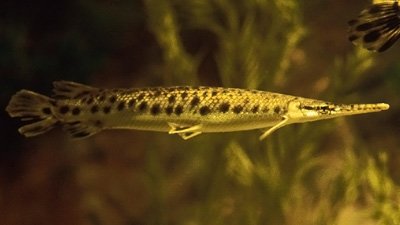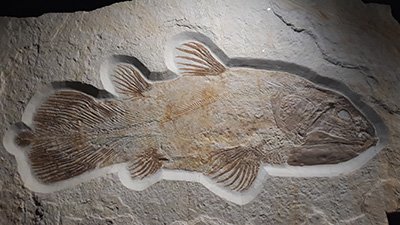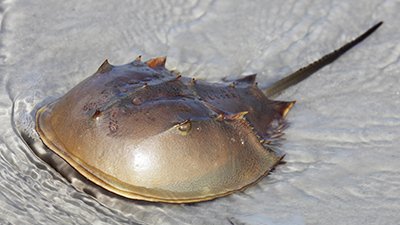Living Fossils
Living Fossils
“Living fossil” typically describes a living organism that looks like a fossilized organism but has no close living relatives by evolutionary reckoning. While dinosaurs no longer walk the earth (as far as we know), we can still observe living examples of animals and plants that shared the world with dinosaurs.
Living Proof
“Living fossils” pose a conundrum. Why would some creatures remain virtually unchanged from those found in the fossil record, while others changed radically? The answer is easy for creationists.
Fish Story - Coelacanth
No one has told this allegedly 350-million-year-old fish that it was supposed to have been extinct for 65 or 70 million years, which is why it keeps turning up—and conveniently reminding us of the fallibility of the supposed indisputable science evolutionary paleontologists feed the public.
Spider Fossilized in Amber
Huntsman spiders have made no evolutionary progress or even any speciation changes since this one managed to get himself entombed. He appears as modern as his descendants. This fact does not surprise us, since we are confident that the amber is no more than a few thousand years old.
News About Living Fossils
-
March 28, 2024 from Ken Ham Blog
A recent news item caught my eye, as it stated that “a biological mechanism can explain [gar’s] status as ‘living fossils.’”
-
Nov. 23, 2022 from Ken Ham Blog
The clam species a researcher recently discovered wasn’t really a new species. It had been observed and documented before . . . as a fossil.
-
Feb. 18, 2021 from Ken Ham Blog
Evolutionists consider this famous six-foot fish a “living fossil”—a term steeped in assumptions and fanciful storytelling, not observational science.
Articles About Living Fossils
-
Jan. 1, 2020 from Answers Magazine
Evolutionists like to talk about change, so how do they explain so many living creatures that look like their fossilized ancestors?
-
Dec. 14, 2019 from The New Answers Book 4
“Living fossils” are organisms that can be found both living in the world today and also found preserved in the rock record as fossils.
-
Magazine Department ArticleShell SurvivorJan. 1, 2016 from Answers Magazine
Creation biologists don’t find the existence of living fossils so mysterious.
-
Dec. 8, 2013 from Answers Magazine
Far from being an oddity, living fossils are found throughout the fossil layers.
-
An Eel Emerges as the Next Living FossilAug. 20, 2011 from News to Know
Dubbed Protoanguilla palau—meaning “first eel”—this little eel is prompting a redrawing of his family tree. Discovered in western Pacific caves 35 meters deep, the eel seems like a patchwork from the eel time machine.
-
Tropical HuntsmanMay 28, 2011 from News to Know
Tropical Huntsman spider trapped in Baltic amber for millions of years?
-
Great Sea Depths Hiding Ancient CreatureNov. 27, 2010
Great sea depths have been hiding an ancient creature. Is it Leviathan?
-
Magazine Department ArticleLiving ProofJuly 1, 2010 from Answers Magazine
A giant salamander has been discovered in rock layers that evolutionists date at 30 million years. Yet it is virtually identical to giant salamanders living today.
-
Magazine ArticleLiving Fossils: Detachable ChartJan. 1, 2010 from Answers Magazine
Living fossils are found throughout the fossil layers.
-
Living Fossil Found In Grape-Sized CellNov. 29, 2008 from News to Know
A grape-sized cell inching along the ocean floor may be one of the world’s “oldest” living fossils.
-
World's Oldest Flying Insect Fossil Found In MassachusettsOct. 18, 2008
The world’s oldest (allegedly) fossilized impression of a flying insect wasn’t found in a rock quarry in an exotic setting; it was found behind a strip mall in suburban Massachusetts.
-
Sorry, But You Are Extinct: the Coelacanth's StoryAug. 4, 2007
Further studies are performed upon the living fossil, the coelacanth
-
Living Fossil: LobsterMay 5, 2007
For once, the evolutionists have found something that they believe is too old.
-
A Tree of Today?April 21, 2007
A study published in this week’s issue of the science journal Nature describes two recent discoveries of the world’s oldest (allegedly) tree fossils.
-
Magazine Department ArticleRodent Resurrected?July 1, 2006 from Answers Magazine
When an animal or plant has gone “extinct”, and then is found living today, unchanged from what is found in the fossil record, this shocking discovery is called a “living fossil”
-
Fossil Turtles Confound EvolutionistsApril 18, 2005
Australian scientists announced in February the discovery of dozens of fossilized sea turtles that they say have exciting implications for evolution.
-
Magazine Article‘Dinosaur Tree’ Behind BarsJune 1, 2001, pp. 56–57
The botanic gardens in Australia’s national capital, Canberra, has on show a tree which is presently so rare that it is grown in a special cage (pictured, left).
-
Magazine ArticleLily of the SeaDec. 1, 1997, pp. 54–55
The beautifully preserved fossil is of a crinoid, or sea-lily.
-
-
Magazine ArticleLiving Fossils: Acer MonspessulanumJune 1, 1996, pp. 41–42
Most of the public are unaware that there are literally thousands of different types of animals and plants which are alive and essentially unchanged from the way they appear as fossils.
-
Magazine ArticleLiving Fossils: Busycon ContrariumSept. 1, 1995, pp. 6–7
Most of the public are unaware that there are literally thousands of different types of animals and plants which are alive and essentially unchanged from the way they appear as fossils.
-
Magazine ArticleLiving Fossils: AnthedonsJune 1, 1995, pp. 52–53
Most of the public are unaware that there are literally thousands of different types of animals and plants which are alive and essentially unchanged from the way they appear as fossils.
-
Magazine ArticleSensational Australian Tree . . . Like “Finding a Live Dinosaur”March 1, 1995, pp. 13–14
Any time someone finds a “living fossil” this supports the creation model by showing that things either have not evolved, or the vast ages are not real—or both.
-
Magazine ArticleLiving Fossils: PleurotomariasMarch 1, 1995, pp. 52–53
Most of the public are unaware that there are literally thousands of different types of animals and plants which are alive and essentially unchanged from the way they appear as fossils.
-
Magazine ArticleLiving FossilsDec. 1, 1994, pp. 28–29
There are literally thousands of different types of animals and plants which are alive and essentially unchanged from the way they appear as fossils. The polistes wasp is one example.
-
Magazine ArticleLiving Fossils: Antrimpos and PenaeusMarch 1, 1994, pp. 6–7
It could hardly be more obvious that this shrimp is essentially the same as this fossil shrimp. Yet according to evolutionary theory, they are separated by an alleged 150 million years.
-
Magazine ArticleLiving Fossils: Ferns and CrabsDec. 1, 1993, pp. 6–7
There are literally hundreds of different types of animals and plants which are alive and well and which are essentially unchanged from the way they appear as fossils.
-
Magazine Article‘Living Fossil’ in Australian CavesSept. 1, 1993, pp. 23–24
A rare blind crustacean has been found in Jenolan Caves in New South Wales, Australia.
-
Magazine ArticleLiving Fossils: Flowers and FishSept. 1, 1993, pp. 45–46
Most of the public are unaware that there are literally hundreds of different types of animals and plants which are alive and which are essentially unchanged from the way they appear as fossils.
-
Magazine ArticleRare Fossil Insect Discovery by Creationist Confirms ‘No Change’Sept. 1, 1992, pp. 20–21
In Caribbean amber (fossilized tree resin which may contain the bodies of insects), originally lent to the writer for identification of its enclosed insects, an unusual specimen caught his attention.
Recommended Resources

Answers in Genesis is an apologetics ministry, dedicated to helping Christians defend their faith and proclaim the good news of Jesus Christ.
- Customer Service 800.778.3390
- Available Monday–Friday | 9 AM–5 PM ET
- © 2025 Answers in Genesis









